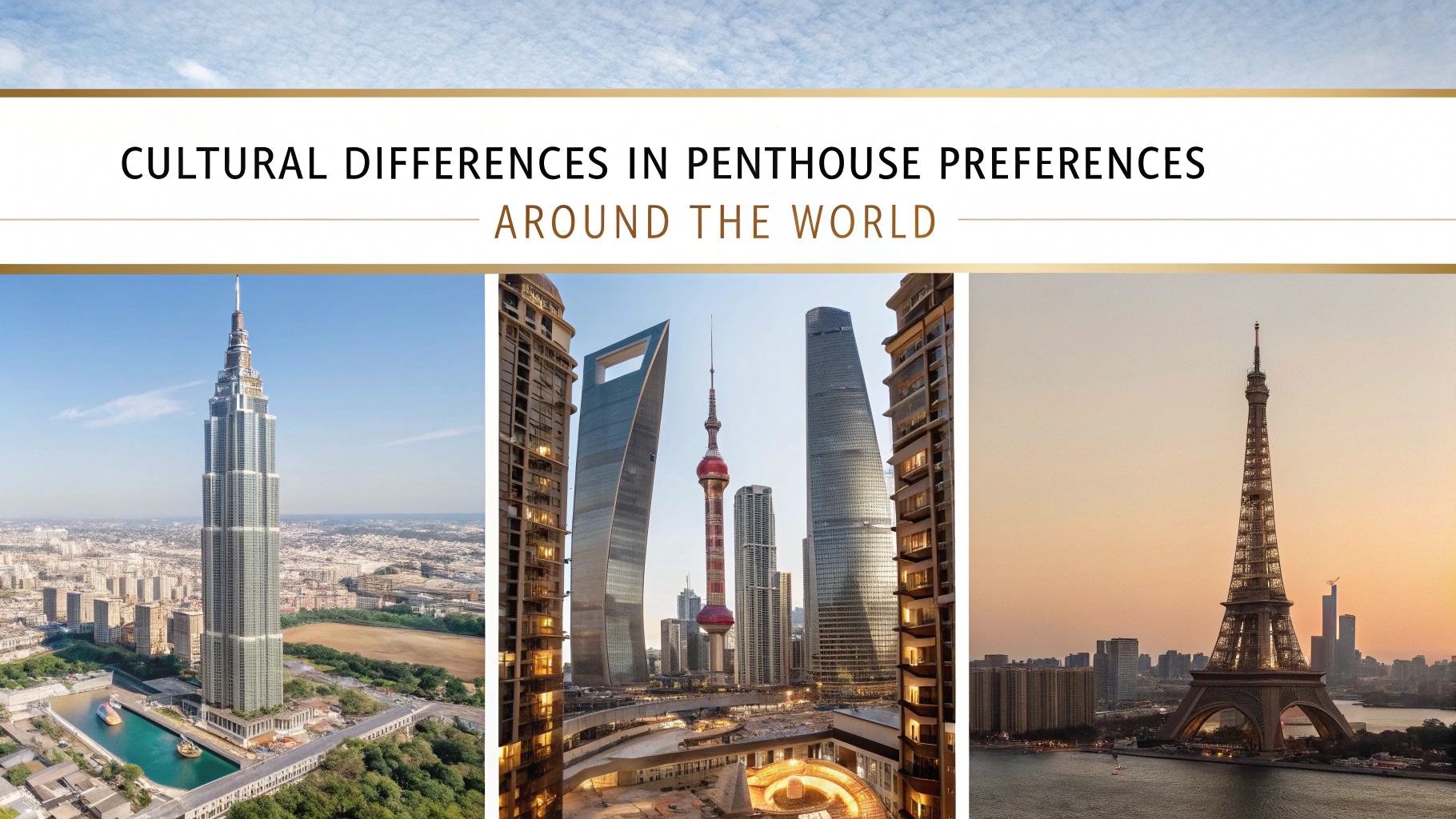When I think about penthouses, I envision luxurious living spaces perched atop skyscrapers, offering breathtaking views and an air of exclusivity. The allure of penthouses has captivated many, making them a symbol of status and sophistication. As I delve into the world of penthouse preferences, I realize that these opulent spaces are not merely about lavish interiors or stunning vistas; they reflect the cultural nuances and personal tastes of their inhabitants.
Each penthouse tells a story, shaped by the values and aesthetics of the culture it emerges from. In exploring penthouse preferences, I find it fascinating how these spaces can vary dramatically across different regions and cultures. The design elements, color palettes, and even the layout can be influenced by a myriad of factors, including historical context, social norms, and individual aspirations.
As I embark on this journey through the world of penthouses, I aim to uncover the intricate tapestry of influences that shape these luxurious abodes, revealing how they serve as a canvas for personal expression and cultural identity.
Cultural Influences on Penthouse Design
Local Materials and Traditions
The materials used in penthouse construction and decoration frequently reflect regional traditions and available resources. In some regions, there is a preference for natural materials like wood and stone, which evoke a sense of warmth and connection to nature. In contrast, urban environments often favor sleek metals and glass, embodying a modern aesthetic that aligns with the fast-paced lifestyle of city dwellers.
Design Choices as Reflections of Values
As I delve into these cultural influences, I am reminded that every design choice is imbued with meaning, serving as a reflection of the values and beliefs held by those who inhabit these luxurious spaces.
Penthouse Preferences in Western Cultures
In Western cultures, penthouses often embody a blend of modernity and tradition, showcasing a penchant for minimalism while still embracing comfort and elegance. As I observe various penthouse designs across cities like New York and London, I notice a common thread: an emphasis on open spaces flooded with natural light. Large windows are a hallmark of Western penthouses, allowing residents to enjoy panoramic views while creating an airy atmosphere that feels both expansive and inviting.
Additionally, Western penthouses frequently incorporate high-end finishes and state-of-the-art technology. From smart home systems to gourmet kitchens equipped with top-of-the-line appliances, these spaces cater to a lifestyle that values convenience and luxury. However, I also see a growing trend towards sustainability in Western penthouse design.
Many residents are now opting for eco-friendly materials and energy-efficient systems, reflecting a broader cultural shift towards environmental consciousness. This blend of luxury and responsibility is reshaping what it means to live in a penthouse in the West.
Penthouse Preferences in Eastern Cultures
In contrast to Western preferences, Eastern cultures often emphasize harmony with nature and spiritual elements in their penthouse designs. As I explore penthouses in cities like Tokyo or Hong Kong, I am struck by the incorporation of natural elements such as water features, gardens, and traditional materials like bamboo or rice paper. These design choices are not merely aesthetic; they reflect a deep-rooted belief in the importance of balance and tranquility within living spaces.
Moreover, Eastern penthouses often prioritize functionality alongside beauty. Space is at a premium in many urban areas, leading to innovative design solutions that maximize utility without sacrificing style. For instance, I notice multifunctional furniture that can be easily reconfigured to suit different needs throughout the day.
This adaptability is a testament to the resourcefulness inherent in Eastern design philosophies, where every element serves a purpose while contributing to an overall sense of peace and serenity.
The Role of Tradition in Penthouse Design
Tradition plays an essential role in shaping penthouse design across cultures. As I delve deeper into this aspect, I recognize that many penthouses incorporate elements that pay homage to historical styles or cultural practices. In Western contexts, for example, I often see penthouses that blend contemporary design with classical influences—think ornate moldings paired with sleek furniture.
This fusion creates a unique aesthetic that honors the past while embracing modernity. In Eastern cultures, traditional motifs are frequently woven into the fabric of penthouse design. Whether it’s through the use of calligraphy in wall art or the arrangement of furniture according to Feng Shui principles, these elements serve as reminders of cultural heritage.
As I reflect on this interplay between tradition and modernity, I appreciate how it enriches the living experience within penthouses. Each design choice becomes a dialogue between past and present, allowing residents to connect with their roots while enjoying the comforts of contemporary life.
Modern Trends in Penthouse Preferences
As I observe the evolution of penthouse preferences in recent years, it becomes clear that modern trends are heavily influenced by lifestyle changes and technological advancements. One notable trend is the rise of biophilic design—an approach that seeks to connect inhabitants with nature through the use of natural materials, greenery, and ample natural light. Many modern penthouses now feature indoor gardens or green walls that not only enhance aesthetics but also improve air quality and overall well-being.
Another trend gaining traction is the integration of smart technology into penthouse living. From automated lighting systems to advanced security features, technology is transforming how we interact with our living spaces. As I explore these innovations, I am excited by the potential they hold for enhancing comfort and convenience in daily life.
However, I also recognize the importance of balancing technology with human connection; after all, a home should be a sanctuary that fosters relationships as much as it embraces modern conveniences.
Factors Influencing Penthouse Preferences
Several factors influence penthouse preferences beyond cultural context and design trends. Economic considerations play a significant role; as I navigate through various markets, I notice how fluctuations in real estate prices can impact what buyers seek in a penthouse. In booming markets, there may be a greater demand for extravagant features like private pools or rooftop terraces, while more modest markets might see preferences shift towards practicality and affordability.
Additionally, personal lifestyle choices significantly shape penthouse preferences. For instance, individuals who prioritize entertaining may opt for open-concept layouts with expansive dining areas, while those who value solitude might prefer cozy nooks or private balconies for quiet reflection. As I engage with residents from diverse backgrounds, I am continually reminded that each person’s vision of their ideal penthouse is uniquely their own—a reflection of their aspirations, values, and lifestyle choices.
Embracing Diversity in Penthouse Design
As I conclude my exploration of penthouse preferences across cultures, I am left with a profound appreciation for the diversity that exists within this realm of luxury living. Each penthouse is not just a physical space; it is a manifestation of cultural identity, personal taste, and historical context. From the minimalist elegance found in Western designs to the harmonious balance celebrated in Eastern aesthetics, there is so much to learn from these varied approaches.
Embracing this diversity enriches our understanding of what it means to create a home—especially one as unique as a penthouse. As we move forward into an increasingly globalized world, I believe it is essential to honor these differences while also finding common ground in our shared desire for comfort and beauty. Ultimately, whether one seeks opulence or simplicity, tradition or innovation, the world of penthouses offers endless possibilities for expression and connection—a true testament to the art of living well.
FAQs
What are some cultural differences in penthouse preferences around the world?
Some cultural differences in penthouse preferences around the world include the size and layout of the penthouse, the amenities and facilities offered, the location and view, and the design and decor.
How do cultural differences influence the size and layout of penthouses?
In some cultures, larger families may prefer penthouses with more bedrooms and living space, while in other cultures, smaller, more intimate layouts may be preferred. Additionally, cultural preferences for open floor plans or more compartmentalized spaces can also influence the layout of penthouses.
What amenities and facilities are preferred in penthouses in different cultures?
Cultural preferences for amenities and facilities in penthouses can vary widely. For example, some cultures may prioritize access to communal spaces such as rooftop gardens or swimming pools, while others may prioritize private amenities such as personal gyms or home theaters.
How does location and view influence penthouse preferences in different cultures?
In some cultures, penthouses located in bustling urban centers may be highly sought after, while in others, penthouses with serene natural views or waterfront locations may be preferred. Cultural attitudes towards privacy and security can also influence preferences for penthouse location.
How does cultural influence impact the design and decor of penthouses?
Cultural differences can influence the design and decor of penthouses in terms of color schemes, furniture styles, and decorative elements. For example, some cultures may prefer minimalist, modern design, while others may favor more ornate and traditional styles.

